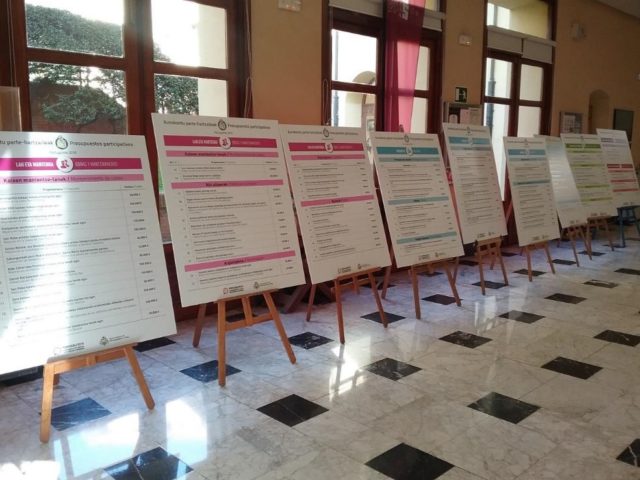Participatory budgeting, some issues
Author: Annick Laruelle is an Ikerbasque research professor at the department of Foundations of Economic Analysis I of the University of the Basque Country (UPV/EHU).
Participatory budgeting seeks to involve some form of public deliberation in the budget allocation of a city or town. The first process took place in Porto Alegre (Brazil) in the late eighties. 1 Since then the practice spread through the world, with more than 7,000 processes around the world in 2018. The logic underpinning participatory budgeting varies substantially from place to place. 2
In Europe, public authorities are often the initiator of participatory budgeting. The town or city decides how much money to allocate (including the conditions for eligibility to take part and the voting rule to be used), and issues a call for proposals. Citizens make proposals. The town collects and filters them (checking their feasibility and legality). It assigns costs to the admitted ones. Citizens vote. The town announces the winning projects and implements them.
One important issue is how many projects are put to a vote. There is a trade-off between efficiency and transparency in this filter. Any filtering that goes beyond feasibility and legality criteria gives a great deal of discretionary power to the town. In consequence, ballots often include more than one hundred projects (and often much more). This too large number of projects generates a so-called “choice overload”. 3 Moreover, relevant data are not always available: many participatory budgeting processes do not identify potential beneficiaries or the location of the projects.

With numerous projects, ballots can only require voters to approve or rank a limited number of them. When voters approve projects, the participatory budgeting voting rule aims at selecting the set of projects that sum the largest number of votes subject to the budget constraint. When voters rank projects, a weight is associated to the ranking. The score of a given project is increased by the weight of the ranking each time a voter ranks the project. The rule selects the projects with the largest score. For instance the town of Leioa uses the Borda score with 10 options: voters choose and rank 10 projects: The score of a project is increased by 10 whenever it is ranked first, by 9 whenever it is ranked second, … and by 1 whenever it is ranked in the 10th position. The town of Portugalete uses the Dowdall score with 5 options: voters choose and rank 5 projects. The score of a project is increased by 1 whenever it is ranked first, by 1/2 whenever it is ranked second, … and by 1/5 whenever it is ranked in the 5th position. The participatory budgeting voting rule aims at selecting the set of projects that sum the largest scores subject to the budget constraint. Solving this problem is computationally (NP-)hard when the number of projects is large. In practice, greedy algorithms are used: Instead the optimal set of projects being sought, projects are chosen one by one till the money available runs out. The resulting selection may be suboptimal: If the project with the largest score is costly it is better to select two cheaper projects that sum a larger score.

Some ballots are designed to make voters aware of costs. For instance, a knapsack ballot asks voters to approve projects for a total cost that does not exceed the total budget. The limitation of this ballot is that it is tedious to fill in when the number of projects increases and the total budget is large. An alternative is to include the costs in the participatory budgeting voting rule. The rationale is that an expensive project should require more votes than a cheap project in order to be selected. An example of such a rule ranks projects according to their ratio between the number of votes received and the cost of the project. As is well-known in social choice, adopting one voting rule rather than another one is determinant for the selection of projects. This can be illustrated on the voting data of the 2018 participatory budgeting of the town of Portugalete: the Dowdall rule selects 6 projects while a rule based on the ratio between votes and costs would select 14 (cheaper) projects.4 [4]
The choice of a voting rule is thus important although the main issue of participatory budgeting concerns the participation. Very low participation rates are indeed a common feature of most participatory budgeting processes: usually less than 5% of the total population of a municipality take part in the participatory budgeting processes arranged. The literature to date suggests that participants are generally far from representative of the whole population. In Porto Alegre, the bias was in favour of lower income people. In France or Germany, participants were highly educated, socially integrated and interested in politics.
References
- Dias, N., eds., 2018, Hope for democracy: 30 years of participatory budgeting worldwide. Epopeiarecord, ISBN: 978-989-54167-0-7. ↩
- Cabannes, Y., and B. Lipietz, 2017, Revisiting the democratic promise of participatory budgeting in light of competing political, good governance and technocratic logics, Environment and Urbanization 30(1), 67-84. ↩
- Iyengar, S., and M. Lepper, 2000, When choice is demotivating: Can one desire too much of a good thing? Journal of Personality and Social Psychology, 79, 995-1006. ↩
- Laruelle, A., 2020, Voting to select projects in participatory budgeting. European Journal of Operational Research . doi: 10.1016/j.ejor.2020.05.063). ↩